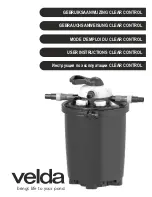
Filtration/Deacidification
Filter systems GENO-mat KF-Z / MS-Z / AK-Z
Deacidification systems GENO-mat TE-Z
Order no. 035 129 950-inter Edited by: nkes-mrie G:\BA-129950-INTER_035_FILTERANLAGEN_GENO-MAT.DOCX
9
B Basic information
1 | Laws, regulations, standards
In the interest of good health, rules cannot be ignored when it comes
to the processing of drinking water. This operation manual takes into
consideration the current regulations and stipulates information that
you will need for the safe operation of your filter system.
Among other things, the regulations stipulate that
only approved companies are permitted to make major modifica-
tions to water supply facilities
and that tests, inspections and maintenance on installed devices
are to be performed at regular intervals.
2 | Designated application/area of application
Gravel filter KF-Z
In general, gravel filter systems are used for the conventional filtra-
tion of impurities in cases where a fine filtration by means of car-
tridge filters would be too costly due to an exceptionally high degree
of pollution. The quartz gravel used retains undissolved substances
such as sand, etc.
Heavy metal compounds in dissolved form such as iron and manga-
nese, however, cannot be removed.
The filter must be backwashed if there is an accumulation of dirt par-
ticles and a pressure drop by approx. 0.3 bar (overpressure). The
backwash is carried out from the bottom to the top, opposite to the
regular direction of flow.
Multi-layer filter MS-Z
Multi-layer filters mostly are used for the conventional filtration of
impurities in cases where a fine filtration by means of cartridge filters
would be too costly due to an exceptionally high degree of pollution.
The hydro-anthrasite H used in addition to quartz gravel is a filter
material composed of carefully sieved, thermally-treated carbon for
the treatment of drinking and process water. The abrasion-resistant
filter material has a rough surface by which a finer filtrate is achieved
compared to a filtration by gravel alone.
The multi-layer filter is able to retain undissolved substances such
as sand, etc. Heavy metal compounds in dissolved form such as iron
and manganese, however, cannot be removed. The filter must be
backwashed if there is an accumulation of dirt particles and a pres-
sure drop by approx. 0.3 bar (overpressure). The backwash is car-
ried out from the bottom to the top, opposite to the regular direction
of flow.










































